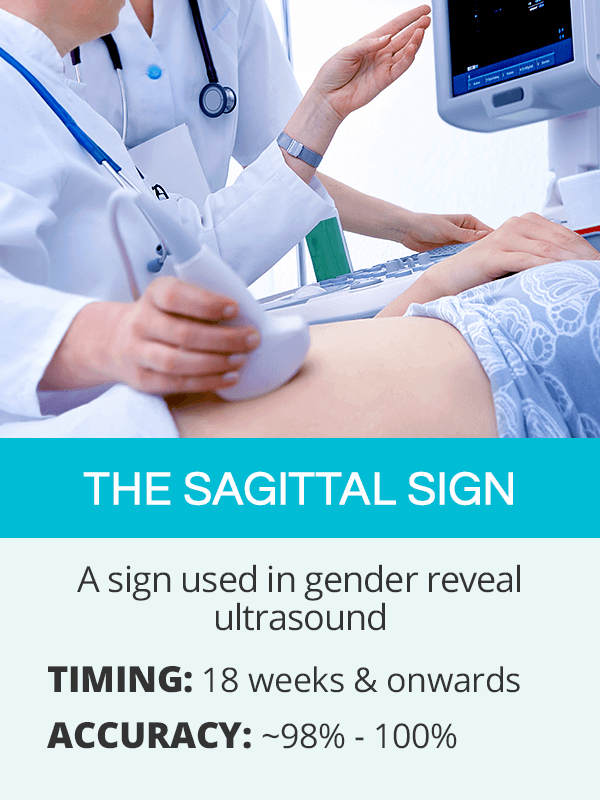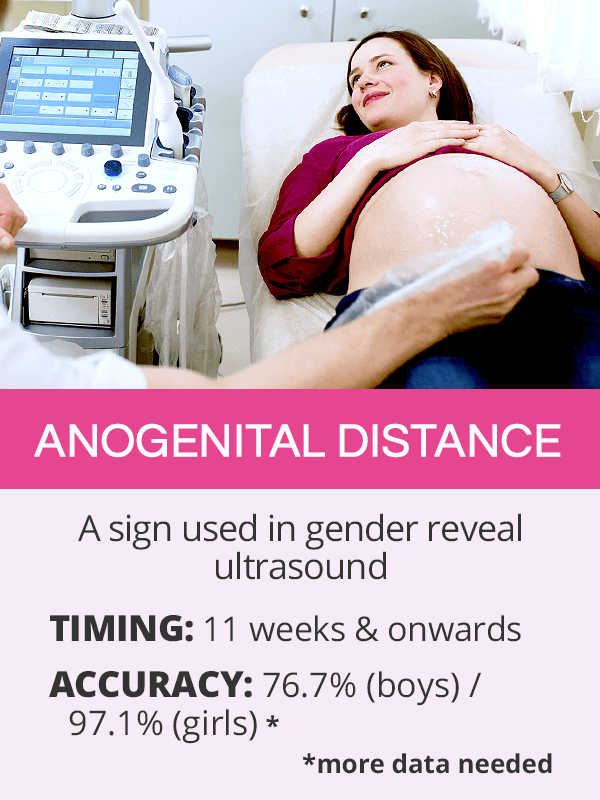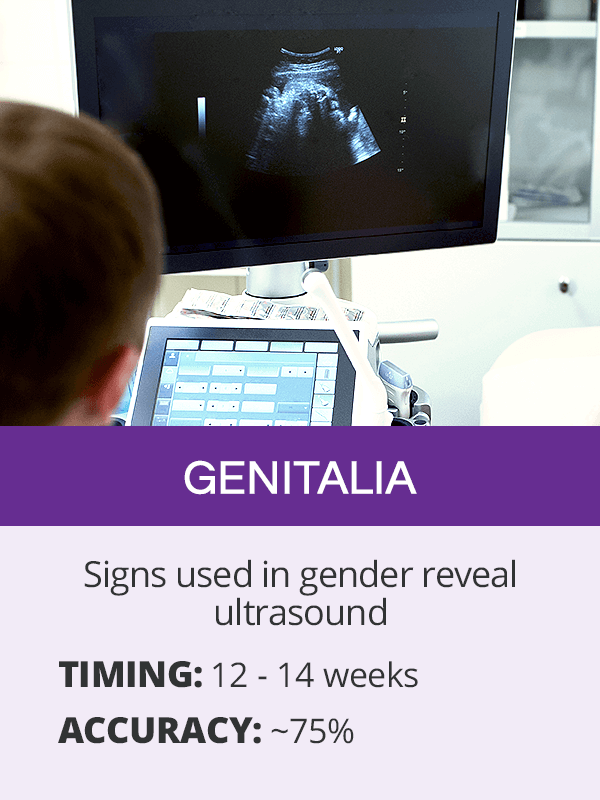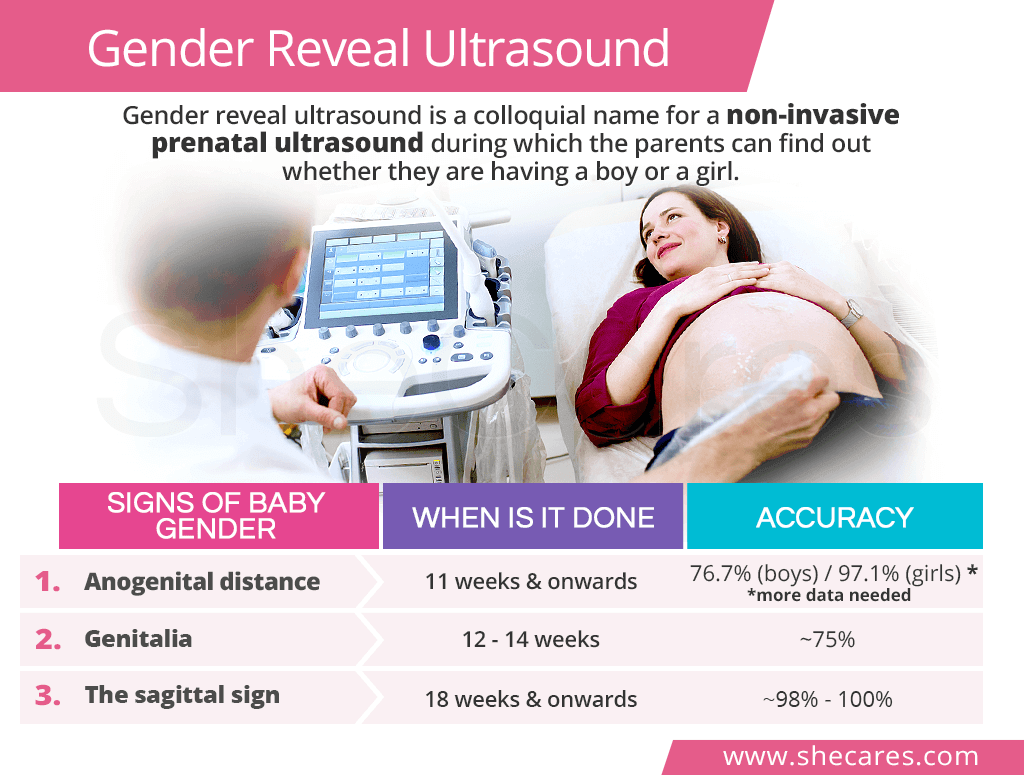A gender reveal ultrasound is a colloquial name for a non-invasive prenatal ultrasound during which the parents can find out whether they are having a boy or a girl.
Contrary to what's commonly believed, a gender reveal ultrasound is not a separate ultrasound examination on its own. Instead, baby's gender can be determined during a routine second trimester ultrasound referred to as a morphology or anatomy scan. It is done between 18th and 20th week to assess fetal development and diagnose any abnormalities.
Early Gender Reveal Ultrasound
A gender reveal ultrasound is scheduled around the 18th week of pregnancy because a clear differentiation of male and female genitals is not possible until about the 14th and 15th week.
However, an earlier ultrasound done after the 12th week of pregnancy can often accurately detect a preliminary structure called the genital tubercle, a precursor of the penis or the clitoris (discussed below).
Gender reveal ultrasounds before the 12th week are not accurate and, therefore, are not practiced.
Boy or Girl Ultrasound Signs
When performing a gender reveal ultrasound, a doctor or a technician will look for certain characteristics associated with male or female sexes, depending on the date of an ultrasound. Three most common ones include the following:
The Sagittal Sign

When a gender scan is done around the 12th and 14th week, what will help determine gender would be the direction in which the genital tubercle points, a characteristic referred to as the sagittal sign.
Initially, both sexes' genitalia look the same and begin differentiating after week nine due to an influx or absence of testosterone. From then onwards, the genital tubercle will continue shaping into either a penis or a clitoris, which - at around the 12th week of pregnancy - can be recognized by the following characteristics:
On a girl ultrasound, the genital tubercle is flat or points downwards at an angle lower than 30° from the spine, forming what is called a caudal notch.
On a boy ultrasound, the genital tubercle points upwards at an angle higher than 30° from the spine, forming what is called a cranial notch2.
Estimated accuracy of predicting baby's gender using the sagittal sign is about 75%.
Anogenital Distance (AGD)

Measuring the anogenital distance, which is the distance between the midpoint of the anus to the genitalia, for gender determination is one of the newest techniques. The differences in AGD in boys and girls are apparent from the 11th week4.
On a girl ultrasound, the mean AGD values are 3.6 mm (<4.8mm).
On a boy ultrasound, the mean AGD values are 5.1 mm (≥4.8mm).
Although data on the accuracy of predicting gender with AGD is limited, one study has shown it is 76.7% accurate in identifying boys and 97.1% accurate in identifying girls5.
Genitalia

When a gender scan is done after the 18th week, what will be the point of reference will be the presence of genitalia: a penis or the clitoris with labia.
A boy ultrasound should show the tip of the penis with testicles, which is often colloquially referred to as the “turtle sign.”
A girl ultrasound should show the clitoris in between the labia appearing as three lines, which is often referred to as the “hamburger sign3.”
Estimated accuracy of predicting baby's gender by observing the genitalia is 98-100%.
Possible Errors of Gender Reveal Ultrasound
It is important to remember that the accuracy of gender reveal ultrasound hugely depends on when it is performed. The more advanced the baby's gestational age, the higher probability that the ultrasound will correctly reveal gender1, 3.
Besides timing of gender reveal ultrasounds, the sonographer's experience also plays a role in their accuracy. Common errors include mistaking the umbilical fold for a penis and confirming a boy or confirming a boy based on the absence of a penis, which was hidden between the baby's legs.
Furthermore, the accuracy is decreased by maternal obesity, twin pregnancy, or the baby's position.
Other Tests to Reveal Baby’s Gender
Besides having a gender reveal ultrasound, there are a number of other prenatal tests that can determine if a couple is having a boy or a girl, although they are administered for other purposes, namely diagnosis genetic abnormalities. They include the following:
Non-invasive prenatal testing (NIPT): a blood test that detects fetal genetic maternal in mother's circulation
Chorionic villus sampling (CVS): a test consists of taking a sample of the placenta for analysis
Amniocentesis: a test involving taking a sample of amniotic fluid for analysis
Key Takeaways
Knowing baby's gender before birth is the desire shared by many mothers around the world, whether because of curiosity or possible transfer of sex-linked genetic disorders. Whether a couple is having a boy or a girl is most commonly revealed between the 18th and 20th weeks of pregnancy during a morphology ultrasound. Although this particular examination is aimed at detecting anatomical abnormalities, it is commonly called a gender reveal ultrasound since it can also confirm gender. During such exam, a technician will attempt to locate various characteristics associated with male or female sexes, such as the sagittal sign, which is the direction of an early structure called the genital tubercle; genitalia; or anogenital distance, which has been found to differ in boys and girls. These sex-related features can be already seen on an ultrasound after the 12th week of pregnancy. Earlier scans are not considered accurate.
Sources
- Acta Obstetricia Gynecologica Scandinavica. (2008). Fetal gender screening by ultrasound at 11 to 13 (+6) weeks. Retrieved August 15, 2019 from https://www.ncbi.nlm.nih.gov/pubmed/17851807
- American Pregnancy Association. (2019). Ultrasound: Sonogram. Retrieved August 15, 2019 from https://americanpregnancy.org/prenatal-testing/ultrasound/
- Better Health. (2014). Pregnancy tests - ultrasound. Retrieved August 15, 2019 from https://www.betterhealth.vic.gov.au/health/healthyliving/pregnancy-tests-ultrasound
- Embryology. (2018). Genital Development. Retrieved August 15, 2019 from https://embryology.med.unsw.edu.au/embryology/index.php/Lecture_-_Genital_Development
- FDA. (2019). Ultrasound Imaging. Retrieved August 15, 2019 from https://www.fda.gov/radiation-emitting-products/medical-imaging/ultrasound-imaging
- ISRN. (2012). Why Do Parents Prefer to Know the Fetal Sex as Part of Invasive Prenatal Testing? Retrieved August 15, 2019 from https://www.hindawi.com/journals/isrn/2012/524537/
- Journal of Family Medicine and Primary Care. (2018). The ultrasound identification of fetal gender at the gestational age of 11-12 weeks. Retrieved August 15, 2019 from https://www.ncbi.nlm.nih.gov/pmc/articles/PMC5958571/
- Mayo Clinic. (2019). Fetal ultrasound. Retrieved August 15, 2019 from https://www.mayoclinic.org/tests-procedures/fetal-ultrasound/about/pac-20394149
- Nigerian Medical Journal. (2012). The accuracy of 2D ultrasound prenatal sex determination. Retrieved August 15, 2019 from https://www.ncbi.nlm.nih.gov/pmc/articles/PMC3530251/
- Woods, Mark. (2010). Pregnancy for Men: The whole nine months. Great Britain: Crimson Publishing.
- UT Southwestern Medical Center. (2016). Boy or Girl? The difficulties of early gender prediction. Retrieved August 15, 2019 from https://utswmed.org/medblog/gender-prediction/
- Ultrasound in Obstetrics & Gynecology. (2006). Fetal gender assignment by first-trimester ultrasound. Retrieved August 15, 2019 from https://www.ncbi.nlm.nih.gov/pubmed/16493625
- Ultrasound in Obstetrics & Gynecology. (2006). Sonographic early fetal gender assignment: a longitudinal study in pregnancies after in vitro fertilization. Retrieved August 15, 2019 from https://obgyn.onlinelibrary.wiley.com/doi/pdf/10.1046/j.1469-0705.2001.00421.x
Footnotes:
- Australasian Journal of Ultrasound in Medicine. (2014). Accuracy of sonographic fetal gender determination: predictions made by sonographers during routine obstetric ultrasound scans. Retrieved August 15, 2019 from https://www.ncbi.nlm.nih.gov/pmc/articles/PMC5024945/
- Journal of Ultrasound Medicine. (1989). The Sagittal Sign: An Early Second Trimester Sonographic Indicator of Fetal Gender. Retrieved August 15, 2019 from https://onlinelibrary.wiley.com/doi/pdf/10.7863/jum.1989.8.6.293
- BJU. (2004). Prenatal gender determination and the diagnosis of genital anomalies. Retrieved August 15, 2019 from https://onlinelibrary.wiley.com/doi/full/10.1111/j.1464-410X.2004.04704.x
- European Journal of Obstetrics & Gynecology and reproductive Biology. (2016). First-trimester determination of fetal gender by ultrasound: measurement of the ano-genital distance. Retrieved August 15, 2019 from https://www.ejog.org/article/S0301-2115(16)30283-4/abstract
- Journal of Maternal-Fetal & Neonatal Medicine. (2019). An appropriate way to predict fetal gender at first trimester: anogenital distance. Retrieved August 15, 2019 from https://www.ncbi.nlm.nih.gov/pubmed/29298531
